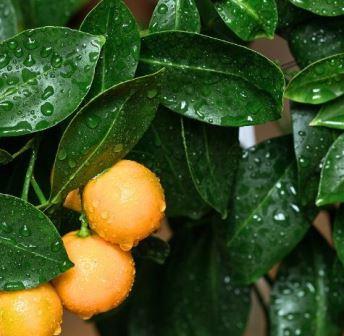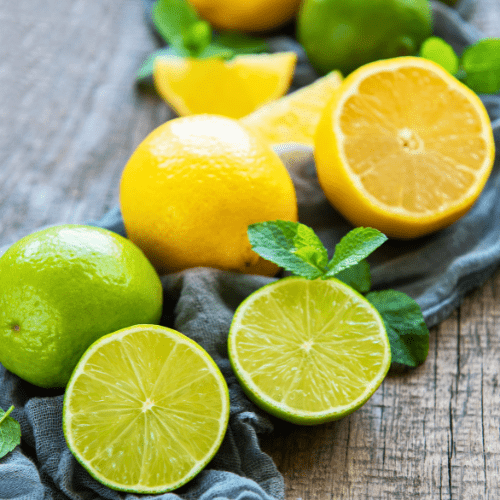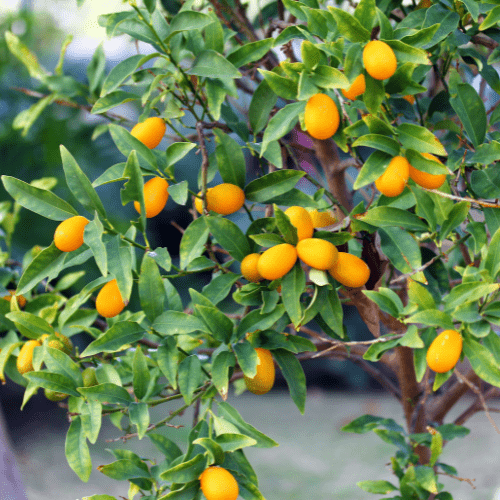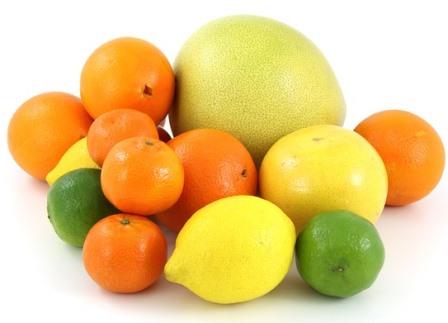The genus Citrus is native to south-east Asia, occurring from northern India to China, and south through Malaysia, the East Indies and the Philippines, with records of domestication going back to around 500 BC.
Citrus form small, compact evergreen trees, and are usually slow growing. With the exception of lemons, which flower up to four times per year, most citrus varieties flower in spring. The buds appear in early August, and by early October the last petals fall, leaving the tiny fruitlets behind.
A mature citrus tree can produce hundreds of thousands of blossoms, yet only about two percent of these will result in edible fruit. This heavy blossom production is nature's way of assuring that insects, attracted by the tree's fragrance, pollinate the maximum number of flowers.
Seventy to eighty percent of the flowers will drop during and immediately following bloom. A second drop of small pea-sized fruits a couple of weeks after blooming will occur - this is perfectly natural.
 Lemon Dwarf 'Eureka'Citrus make the perfect evergreen shade tree and also grow beautifully in pots in courtyards or on balconies. Any variety can be grown in a tub, providing the container is a decent size. Generally, Kumquats and Calamondins are very well-suited to tub-culture, as are Meyer Lemons and Limes.
Lemon Dwarf 'Eureka'Citrus make the perfect evergreen shade tree and also grow beautifully in pots in courtyards or on balconies. Any variety can be grown in a tub, providing the container is a decent size. Generally, Kumquats and Calamondins are very well-suited to tub-culture, as are Meyer Lemons and Limes.
With the proper care, good cultural practices, and a favourable rootstock, a citrus tree is capable of producing fruit in excess of 50 years. One such example is the original Washington Navel orange brought first from Brazil to Washington D.C. and then to California in 1873. One hundred years later it was still alive and producing fruit.
Depending on the variety, a mature citrus tree is capable of producing up to 1 000 pounds of fruit per season. Maximum yields will vary according to the variety grown, weather conditions, cultural care, the age of the tree, and many other factors.
Citrus Problems:
Yellow Leaves
It is not uncommon for citrus leaves to go yellow during winter or after a heavy cropping of fruit and this can be corrected in spring with fertilisation. Yellowing can also occur if the ground is too wet and the drainage is not excellent.
Mineral deficiencies can also cause a yellowing and mottling of the foliage and it is usually a deficiency of iron, zinc, magnesium or manganese that is causing the problem.
Trelmix, a trace element solution which promotes growth and corrects chlorosis (yellowing), blotching and stunting where these are due to trace element deficiencies can be applied.
Zinc deficiency
Zinc deficiency shows a fishbone-like pattern on the leaves with a yellowing between the leaf veins. Sandy soils may need additional zinc and red sandy soil may need potassium.
Click here to see Google images of Zinc deficiency in Citrus
Manganese deficiency
Manganese deficiency cause yellow blotches between the leaf veins. It is fairly common, especially in autumn. The leaves will go yellow with a green V-shaped area at the base leaf.
Click here to see Google images of Manganese deficiency in Citrus
To correct this give a mature tree 2,5kg of magnesium sulphate (Epson Salts) and for a young tree about 250g.
Iron deficiency.
Citrus may exhibit Iron deficiency in the early spring. Usually the deficiency clears up as the soil warms up. If it does not, a soil application of iron chelate should sort out the problem.
Clay soils usually contain plenty of iron, but where iron deficiency does occur, do not use fertilizers which contain phosphorous because high phosphorous aggravates iron and zinc deficiency in high pH (alkaline) soils.
Click here to see Google images of Iron deficiency in Citrus
Nitrogen:
Mature citrus trees should receive enough nitrogen to provide for good but not excessive leaf growth.
 Calamondin OrangeUse Pesticides & Fungicides Responsibly
Calamondin OrangeUse Pesticides & Fungicides Responsibly
Even if you have a healthy citrus tree which is planted in the correct position and soil, and is feed and water correctly, it may still succumb to diseases. Insects also occasionally trouble citrus trees in home gardens and may require spraying, but rarely will these pests render the fruit inedible or seriously threaten the health of the plant.
The use of pesticides in the home garden should be restricted to a minimum and whenever possible organic products should be used. There is a natural balance in nature between pests and their natural predators, and when harsh pesticides are used continuously this balance is disturbed, and a vicious cycle is created; resulting in the trees having to be sprayed all the time. Apart from the damage caused to the environment, the cost factor can also be enormous.
If you do have spray, always use organic products and follow the dilution rates and spraying times meticulously. Always add a wetter/sticker to the spray mixture when spraying citrus trees, as their leaves are very glossy and a sticker helps the spray stick to the leaves.
Good cultural practices
Good, clean cultural practices will help to keep insects and diseases to a minimum and citrus can easily be grown organically.
Find out which citrus varieties grow best in your area
The first step toward successfully growing citrus trees is to take the time to find out which varieties grow best in your area and to purchase them from a reputable nursery.
Citrus trees are subtropical to tropical in nature and they suffer severe damage or even death because of freezing temperatures. However, several types of citrus have sufficient cold-hardiness to sustain some freezing conditions, particularly as mature trees.
Select a healthy tree
The tree you select should have healthy, deep green leaves, the trunk should be straight and the tree should be able to support itself without a stake.
Young grafted trees will start producing fruit when still very young, but it is best to remove all fruit until the trees are more mature. Fruiting takes a lot of energy from the young tree and by removing it, the plant can conserve energy, allowing it to adapt to its new environment and grow new roots and leaves.
 Lime Sweet Dwarf Citrus Pests
Lime Sweet Dwarf Citrus Pests
Ants:
The brown house ant and the pugnacious ant are the one of the most important insects to control near citrus trees, because they protect and 'farm' certain insects like scale and aphids, for the honeydew they secrete. Ant nests, particularly those of the pugnacious ant, if present underneath or near the trees, must be treated immediately.
Ludwigs Insect Spray is a broad spectrum insecticide that contains garlic juice, canola oil and natural pyrethrum. It is certified to control ants and many other garden insects. Canola oil kills small-bodied insects on contact by means of suffocation, and garlic keeps insects away from plants. Pyrethrum has a stomach poison activity of about 24 hours. This formulation has a very low toxicity to mammals, with no secondary poisoning. It is however, toxic to fish and moderately toxic to bees. Edible crops can be harvested 48 hours after applying.
Scale Insects:
Click here to see Google images of Citrus Scale
There are many types of hard (armoured) and soft scale insects, and they can be various colours, like brown, red, purple, grey, white, green etc.
Pernicious and red scale, as well as soft brown scale are a common problems on citrus as well as many other garden plants, and can be present all year round. A sure sign that you have scale is if there are ants running up and down the branches.
Young scales are mobile crawlers and adult males have tiny wings, making them more mobile than the females. Mostly, the adults attach themselves to the bark, leaves and fruit, sucking out the plant sap through their needle-like mouthparts. Scale insects generally excrete honeydew, on which a fungus called sooty mould grows. Sooty mould is black and looks worse than it really is, and doesn't hurt the leaves or fruit.
Scale insects are 'farmed' by ants for their sugary excretions, and in return, the ants protect the scale from their natural predators like; ladybirds and their larvae, lacewings and predatory thrips.
Many types of scale are controlled satisfactorily by their natural enemies, provided ants are kept out of the trees, get rid of the ants around your trees and the sooty mould and the scale will disappear.
Severe infestations can cause the leaves to turn yellow and drop and may kill young trees. It will cause die-back of the twigs and can kill entire branches on more mature trees.
To control bad infestations, remove all badly infested branches completely in winter and burn them. The best time to spray for scale is also in winter but mineral oils can be sprayed in summer, as long they are applied during the coolest part of the day. Mineral oils like Oleum work the best, killing most species of scale on contact. If infestations are very severe you should apply three applications within 10 days, ensuring full coverage of the tree.
Products containing Canola oil, like Margaret Roberts Insecticide will also suffocate scale. Ludwigs Insect Spray is a broad spectrum insecticide that contains garlic juice, canola oil and natural pyrethrum. It is certified to control many garden insects. Canola oil kills small-bodied insects on contact and garlic keeps insects away from plants. Pyrethrum has a stomach poison activity of about 24 hours. This formulation has a very low toxicity to mammals, with no secondary poisoning. It is however, toxic to fish and moderately toxic to bees. Edible crops can be harvested 48 hours after applying.
Brown Citrus Aphid:
Click here to see Google images of Brown Citrus Aphid
Aphids are soft-bodied insects that suck the sap from plants and can therefore spread viral diseases from one plant to another. Young aphids are wingless and adults can be winged or wingless. The various species vary in colour and can be dark brown, light and dark green, red-brown, pale yellow, grey and black.
The aphids secrete honeydew which attracts ants and other insects. Ants farm the aphids for the honeydew, and in return, protect the aphids from their natural predators such as ladybirds, parasitic wasps and praying mantis. Aphids love fresh new plant growth and can cause distorted and malformed growth, and stunting of the plants growth. Black sooty mould is a fungus that grows on the honeydew, but this fungus will not damage the leaves or fruit. Get rid of the aphids and ants and the mould will disappear.
Margaret Robert's Organic insecticide controls small-bodied insects and is authorised for use in organic agriculture. It contains garlic juiced extract and canola oil and is used to control aphids and many other garden insects. Canola oil kills small-bodied insects on contact by means of suffocation, and garlic keeps insects away from plants.
It has a low impact on bigger bodied beneficial insects and natural predators and the product is harmless to fish, birds, wildlife, pets and humans. However, never allow oil formulations to form a layer over water surfaces as huge quantities of any oil will cut off the oxygen supply to aquatic organisms, resulting in harm to aquatic life like fish and frogs. No harmful toxic residues remain in the environment for prolonged periods and edible crops can be harvested within 24 hours.
Citrus Thrips:
Click here to see Google images of Citrus Thrips
Severe attacks by thrips will cause young shoots and leaves to become thickened and distorted, and developing shoots may turn black and fall off. During development, the peels of young citrus fruit can also be blemished by citrus thrips. This mostly starts from the stem end and may spread downwards, extending over the rest of the fruit, but does not, however, affect the eating quality of the fruit.
Ludwigs Insect Spray is a broad spectrum insecticide that contains garlic juice, canola oil and natural pyrethrum. It is certified to control thrips as well as many other garden insects. Canola oil kills small-bodied insects on contact by means of suffocation, and garlic keeps insects away from plants. Pyrethrum has a stomach poison activity of about 24 hours. This formulation has a very low toxicity to mammals, with no secondary poisoning. It is however, toxic to fish and moderately toxic to bees. Edible crops can be harvested 48 hours after applying.
Citrus Psylla:
Click here to see Google images of Citrus Psylla
Psylla causes unsightly bumps on the leaves, especially the fresh young leaves, and is caused by citrus gall wasps. They are the transmitter of a major citrus disease known as greening. Citrus trees have three growth flushes a year: one in August/September, followed by another in November/December and the last during February/March. Lemons are the exception, forming new leaves throughout the year. It is during these flushes that the trees are susceptible to psylla infestation.
The female citrus gall wasp lays discernible orange-yellow eggs on the edges of the young leaves. When the eggs hatch, the young nymphs move to the underside of the leaves and establish themselves to feed, causing pock-like malformations on the leaves.
Control of the pest must be aimed at destroying the nymphs as soon as possible after they have hatched. Because all the eggs do not hatch at once, it is essential to use a spray with a fairly long residual action and to spray regularly - as subscribed on the bottle. Check your trees regularly for the eggs and begin spraying immediately, ensuring that all the leaves are thoroughly covered.
For citrus psylla use organic sprays such as Biogrow Pyrol, Biogrow Bioneem, or a homemade Neem Oil and soap solution. Neem-based products work by disrupting the insect's life cycle and can be used as a preventative, while Pyrol and soap solutions provide contact killing by suffocation and direct contact. For best results, apply to the entire tree, especially the underside of leaves, and reapply as needed to control the pest's life cycle.
Citrus Leaf Miner:
Click here to see Google images of Citrus Leaf Miner
Leaf miner attacks can occur at any time of the year, especially in warm and humid regions, causing the leaves to curl and go brown, with distorted twisted new growth, and squiggly lines in the leaves. This pest can really make the trees look unsightly. There are several types of leaf miner and tiny moths, beetles or flies are the adult stage. Damage to plants is done at the larval stage, when they feed within the leaves, and heavy infestations will affect yields.
Leaf miners need to be controlled, especially in young trees by spraying every time they put out a new flush of leaves. The insects can be found on weeds, flowers and vegetables, so keep the ground around your trees weed- free. The best control is obtained when infestations are detected at an early stage.
Physically removing infected leaves will help control larvae growing inside the leaves, and spraying with a contact poison containing Canola oil or natural Pyrethrins will control the adults, if sprayed weekly.
Ludwigs Insect Spray is a broad spectrum insecticide that contains garlic juice, canola oil and natural pyrethrum. It is certified to control many garden insects. Canola oil kills small-bodied insects on contact and garlic keeps insects away from plants. Pyrethrum has a stomach poison activity of about 24 hours. This formulation has a very low toxicity to mammals, with no secondary poisoning. It is however, toxic to fish and moderately toxic to bees. Edible crops can be harvested 48 hours after applying.
Citrus Mealybugs:
Click here to see Google images of Citrus Mealybugs
Citrus mealy bugs are a common garden pest, and there are many mealybug species. They are small white, oval insects that are covered in mealy waxy threads, and can be found on the undersides of the leaves, the leaf joints, and crevices, where they are not easily noticeable. They suck the sap of plants and can therefore transmit viruses. If infestations are severe, they can cause severe wilting of the soft, new shoots, leaf discolouration and severe leaf drop, yellow spots may develop on citrus fruits.
The sweet honeydew they secrete will cause sooty mould to grow on their secretions. Sooty mould looks worse than it really is and doesn't hurt the leaves or fruit. Mealy bugs are protected and 'farmed' by ants for these sugary excretions. If you get rid of the ants, so that the natural predators of mealy bugs can help control their populations, the mealybugs and the sooty mould will disappear.
Natural predators of mealybugs are ladybirds, parasitic wasps, lacewings and small birds. Mealbug infestations can occur at any time of the year and winter is an ideal time for them to breed in sheltered areas of the garden. Spring and late summer are the best months to spray for control because their natural predators may also be affected by sprays and they are not as active in the cooler months.
Mealybugs can be treated with the same pesticides as for scale and aphids. White mineral oils like Oleum and organic insecticides containing canola oil and natural pyrethrins are effective, suffocating the insects on contact. Ludwigs Insect Spray is a broad spectrum insecticide that contains garlic juice, canola oil and natural pyrethrum. It is certified to control many garden insects. Canola oil kills small-bodied insects on contact and garlic keeps insects away from plants. Pyrethrum has a stomach poison activity of about 24 hours. This formulation has a very low toxicity to mammals, with no secondary poisoning. It is however, toxic to fish and moderately toxic to bees. Edible crops can be harvested 48 hours after applying.
Fruit Flies:
Click here to see Google images of Fruit Flies
Fruit flies attack many species of fruiting plants and cause post-harvest decay on fruit. Fruit flies look like a small housefly and the clear wings have orange and brown patterns. When they rest on fruit the wings are usually horizontal. In South Africa the most common species are the Mediterranean and Natal Fruit fly. Infestations can occur all year round but seem to peak from January to March. They sting the fruit and lay their eggs just below the surface, right after the blossoms have fallen, as well as when the fruit is ripening.
The eggs hatch within three days and the small white maggots begin feeding. Signs of fruit fly infestation will show as a sticky gum oozing out of the still green fruit. After a few weeks the fruit is entirely rotten and falls to the ground. The maggots then burrow into the soil to pupate. Within two weeks a new generation of fruit fly emerges and a new cycle begins.
There are several eco friendly ways to combat this destructive cycle. In May or June brush the tree trunks and any large branches of your fruit trees with a medium hard brush to remove hibernating insects. Remove all mulch and fallen debris from the ground and burn it. In spring, when your trees start to bloom, place a lining of frost cover/ bidum/weed guard on the ground around your trees. This will prevent mature fruit fly, that have survived the winter in the soil, from emerging from the ground.
Once 80% of the blossoms have fallen from your tree you can start spraying with wormwood and garlic or a quassia spray every week. Spray the entire tree as well as the ground around it. Try to do this in the early evening when the bees are in their hives.
Organic formulations like Ludwigs Insect Spray contain pyrethrins and can also be applied every 2 weeks. Baited traps can also be hung in the trees.Continually remove any fruit that appears to be stung and keep good hygiene on the ground.
Orange Dog Caterpillars:
Click here to see Google images of Orange Dog Caterpillars
These can sometimes become a problem in the garden, especially on immature trees, because the larvae feed mainly on the young leaves. The damage caused is the same as for any leaf-eating caterpillars, but seldom will the larvae reach epidemic proportions and a few caterpillars on mature trees will not affect the health of the trees.
The culprit is a beautiful butterfly called the citrus swallowtail, which emerges in spring. It has large wings with bright yellow and black markings, with the distinctive swallowtail at their bases. The spiny backs of the young larvae are black with a white mark. As the larvae mature they become smoother and turn green, with a diagonal black stripe on both sides of the back, and black stripes across the head. They can reach 40mm long and larvae can be present from late spring to autumn.
If only a few are present, they can be collected by hand or you can spray with Margaret Roberts Biological Caterpillar Insecticide, which is a natural product that will control orange dog caterpillars as well as many other garden insects. It contains no toxic residues and is harmless to bees, birds, fish, pets, wildlife, beneficial insects and natural predators. It can cause harm to the young larvae of butterfly species, but has no effect on adult butterflies. It is safe to use on edible crops and they can be harvested directly after application.
 Kumquat 'Meiwa'Citrus Diseases:
Kumquat 'Meiwa'Citrus Diseases:
When it comes to fungal diseases, prevention is always better than cure. Prevention starts with good and clean cultural practices.
Ensure that your soil has perfect drainage and plant your citrus at the correct depth, as planting too deep can be lethal. Keep the area around your trees clean and free of weeds, plant debris and rotting fallen fruits. Sterilise all pruning equipment before pruning. These practices will go a long way in keeping your trees healthy.
Products like Biogrow Phyta, provides a potent, dual-purpose nutrient solution, providing your plants with essential elements to boost their vitality and protect against diseases.
Biogrow Phyta is a potent, dual-purpose nutrient solution that provides your plants with essential elements to boost their vitality and protect against diseases.
Bio-Tricho is another Natural Biological Fungicide consisting of philosphere micro-organisms specifically for controlling Botrytis and root diseases such as Rhizoctonia, Phytophthora, Pythium, Fusarium, etc. as a micro parasite it feeds on damaging plant pathogenes.
To prevent fungal diseases like black spot scab and blossom-end rot in South Africa, organic options are limited, with copper-based fungicides like Ludwig’s Copper Count and Biogrow Copper Soap being the most common and recommended option for control.
Sooty Mould:
Click here to see Google images of Sooty Mould on Citrus
This fungus looks worse than it really is and doesn't hurt the leaves or fruit. This fungus grows on the sugary deposits made by scale insects, aphids and mealybugs, which are protected and farmed for their sugary excretions, by ants. Get rid of the ants and the mould will disappear.
Citrus Black Spot:
Click here to see Google images of Citrus Black Spot
This is common in tropical to subtropical regions. This fungal disease affects many garden plants and is most noticeable on roses if the humidity is high and during prolonged wet weather, especially in autumn. Infection shows on the leaves by the appearance of dark brown to black spots, followed by a yellow radiance around the edges and can result in leaf drop.
Scab:
Click here to see Google images of Citrus Scab
This fungus that can affect the leaves, twigs, and fruit, of susceptible citrus varieties. It can be particularly severe on lemon trees and also occurs on minneola, tangelos and grapefruit, but rarely on sweet oranges. The symptoms are a corky roughness on the leaves and young twigs. The disease starts as small, pale orange, roughly circular, elevated spots that develop well-defined protuberances on one side of the leaf, often with a conical depression on the opposite side. The tops of these wart-like growths usually become covered with a scabby, corky tissue, and the infected spots can often run together, covering large areas. The leaves of badly infected plants become crinkled and distorted and the twigs will develop small masses of similar corky outgrowths on the surfaces.
Scab starts on the fruit by forming irregular scabby spots or caked masses that start off cream to pale yellow and develop to a dull olive-grey with age. Bad infections will cause the fruit to become misshapen, with wart-like or conical growths extending from the surface. On grapefruit the infected areas tend to flatten out, resembling wind scar injury.
The spores are spread by rainfall, heavy dew, irrigation systems, and to some extent by wind. Warm, wet summer weather is ideal for spore germination, when the temperatures reach 24 to 28°C.
To control scab two to three applications of fungicide need to be applied. Citrus scab is similar to apple and pear scab and is treated in the same way. The trees should be sprayed in early spring when the first flush of new leaves is only a few centimetres long. The second application is made at petal fall, and the last one is applied about 3 weeks later.
Scab usually becomes less of a problem as the trees grow older, but routine spraying may often continue to be necessary, particularly on the more susceptible varieties.
Blossom-end Rot:
Click here to see Google images Blossom-end Rot on Citrus
Blossom end rot causes a brown patch of rot on end on the ripened fruit where the blossoms were attached.
Phytophthora:
Click here to see Google images Phytophthora on Citrus
This is a serious disease that affects citrus. It affects the lower trunk and/or root system of the plant. If this fungus is present in your soil, it can cause infection and every time the tree is watered these pathogens can silently invade the roots and lower trunk tissues. This disease is most active when the soil is not allowed to dry out sufficiently between watering, and especially if the lower trunk area is the last part to dry out.
Foot Rot:
Click here to see Google images Foot Rot on Citrus
Foot rot is a fungal disease present in many South African soils. Both sour orange and trifoliate orange rootstocks have some resistance to the disease, so it is not a problem unless the tree is planted too low and the bud union is exposed to the soil or is standing in water.
Tristeza:
Click here to see Google images Tristeza on Citrus
This is a virus disease that kills citrus trees quickly, particularly those growing on sour orange rootstock.
Greening:
Click here to see Google images Greening on Citrus
Greening is prevalent in the relatively cooler, high-lying areas (above 600m). Typical symptoms are yellowing of the leaves and malformed fruit. One side of the fruit does not develop normally and remains smaller, resulting in asymmetrical fruit. The smaller side remains greenish while the rest of the fruit turns orange.
The disease is caused by a bacterium for which no chemical treatment is available. It is transmitted by psylla (see Citrus psylla). As greening is usually localised within one or two branches of the tree, it is advisable to completely cut out the infected branches. Saw them off as close to the trunk as possible. If the entire tree is affected, it would be better to remove and replace it.



